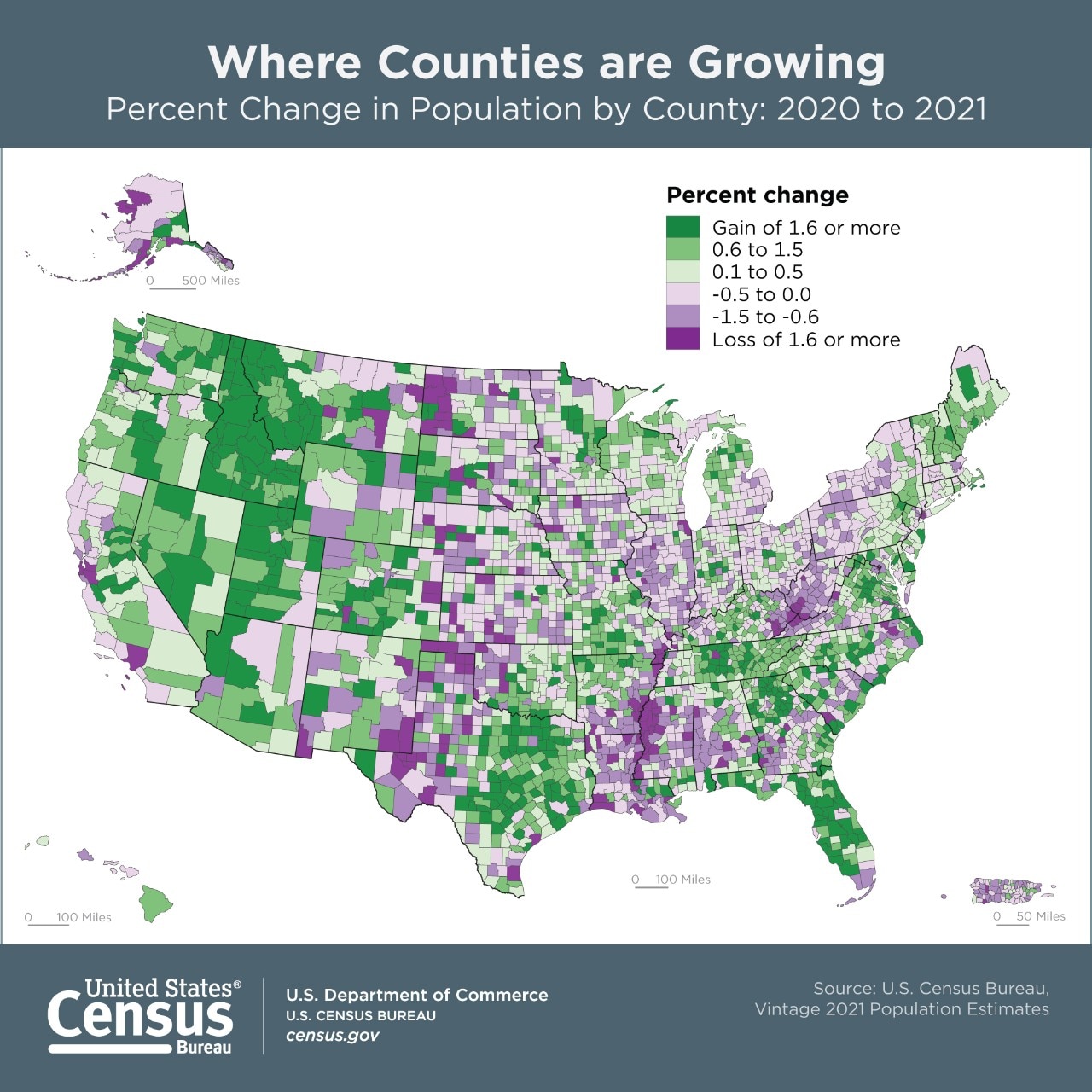According to a recent study conducted by the U.S. Census Bureau, over 73% of the nation’s 3,143 counties experienced a natural decrease in population from July 1, 2020 to July 1, 2021. A “natural decrease” is what happens when there are more deaths than births, and it’s a trend that has been exacerbated by the COVID-19 pandemic. Combined with recent domestic migration numbers, this latest Census report gives a good snapshot of the new areas of population growth in America during the last two tumultuous years.
The natural decrease happened in over two-thirds of America, including every county in Delaware, Maine, New Hampshire, and Rhode Island. The hardest-hit counties were Los Angeles County, which lost 184,465 residents; New York County, which lost 117,375 residents; and Illinois’s Cook County, which lost 102,395 residents. Of the 10 counties that lost the most residents, four were in California, four in New York, and one each was in Illinois and Florida.
On the other side of the equation, Arizona’s Maricopa County reported the largest gain of residents with 58,246, followed by Texas’s Collin County with 36,313 new residents. Of the top 10 counties that gained the most residents, five were in Texas, two were in Florida, and one each was in Arizona, California, and Utah.
Declining Coasts
What’s clear from these stats and the above graphic from the Census Bureau is that the coasts are less attractive than they used to be. The COVID-19 pandemic is an obvious reason why so many people left expensive and congested counties like San Francisco (down 58,764 residents) and New York. When everyone was more or less confined to their own living quarters during quarantines and the typical draws of a big city were unavailable, many younger residents got fed up and headed for more expansive, and less expensive, living situations.
The other trend, which was also accelerated by the pandemic, is the growing number of companies who offer fully-remote jobs. Why pay $5k in rent each month just to be in Manhattan when you have no office to commute to? There are plenty of more affordable places in Texas, for instance, which gained an estimated 400,000 new residents overall during this time period.
What makes these stats interesting is that even the biggest winners don’t match the sheer number that the biggest losers lost, meaning that people aren’t just leaving A to go to B; they’re going all over the country. Many are ending up in Arizona, Texas, and Florida, but there are plenty of other booming midsize metros not accounted for in this data such as Denver, Charlotte, and Atlanta.
It’s easy to say coastal cities are losing residents to Texas, but it may be more accurate to say American cities are evening out. Instead of a few absolutely massive cities at the perimeters of the country and a bunch of smaller ones in between, our future might be a more evenly-spread population throughout our very large nation. And while we can say LA and NYC lost more residents than many cities ever housed, they’re still not exactly small; Los Angeles is still the largest county in the country with a population of 9.8 million. It’s going to take a lot of years of this accelerated rate of decrease before LA gets unseated as one of the largest population centers in America.
Interestingly, rent prices haven’t quite kept pace with all of these recent vacancies. The average rent in Los Angeles, which topped the list with the most outgoing residents, is $2661, which is actually an increase over the last few years. It’s possible there’s a lag in adjustments for the local market, but there are also additional factors to consider such as rising inflation and uneasiness in the markets as a result of the Russian invasion of Ukraine.
How This Affects You
Okay, that was a lot of numbers. And they might be interesting, but what do they mean for you? For one, you can use this data to extrapolate where new population centers will start to emerge.
Texas was a big winner from all of this data, so let’s focus there. Texas’s Denton County gained 27,747 new residents during this period, and Denton County also happens to be home to three colleges: the University of North Texas, Texas Woman’s University, and North Central Texas College. With so many new residents moving in combined with an evergreen need for student housing for its many college students moving in and out every year, Denton County looks like an excellent place to snatch up some rental properties.
One of the cardinal rules of real estate investing is to purchase property where there’s a constant need for housing, and college towns are just about as good as it gets. Areas with growing populations and constant turnover are good bets for any business, and this Census data is a great place to start if you’re considering investment properties in areas outside of your hometown.
Get started with a TurboTenant account for free and manage everything to do with your rental property in one accessible location.

